Lay Family Scottish Origins
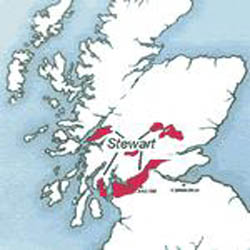

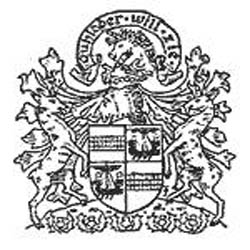
Far left: location of Clan Stewart within Scotland. Center: Stewart of Appin Clan Badge. Far Right:
Shield/crest for Clan Stewart of Appin
The family name of Lay is spread throughout Britain but most noticeable in the west highland region
of Scotland. There are many variations of the name: Lay Lea, Leay Maclae, Maclay, Maclea, MacLeay.
The Lay name appeared in America about the time of the highland purges by the Hanoverian (English)
Army after the 1700’s wars in Scotland against the English. The highlands were then controlled by
the English aristocrats and the clan structure abolished. The remaining scots were forbidden to wear
the kilt and were immediately put to death if caught wearing it.
The center for Appin Stewarts was Castle Stalker – “in the Gaelic, Stalcaire, meaning Hunter or Falconer
– is believed originally to have been the site of a Fortalice (a small fortified building) belonging to
the MacDougalls when they were Lords of Lorn, and built around 1320. The MacDougalls lost their title after
their defeat by King Bruce at Brander Pass in 1308 but regained it for a period after 1328. In about 1388
the Lordship of Lorn passed to the Stewarts, the lands included Castle Stalker.
It is believed that Castle Stalker, much in its present form, was built by the then Lord of Lorn, Sir John
Stewart, who had an illegitimate son in 1446, and it is reasonable to suppose that he built and occupied the
Castle about that time. In 1463 Sir John Stewart was keen to legitimise his son by getting married to his Mother,
a MacLaren, at Dunstaffnage when he was murdered outside the church by Alan MacCoul, a renegade MacDougall,
although he survived long enough to complete the marriage and legitimise his son, Dugald, who became the First
Chief of Appin. The Stewarts had their revenge on MacCoul at the Battle of Stalc in 1468 opposite the Castle when
the Stewarts and MacLaren together defeated the MacDougalls, and Alan MacCoul was killed by Dugald himself. The
site of this Battle is marked by a memorial stone in the Churchyard in Portnacroish.
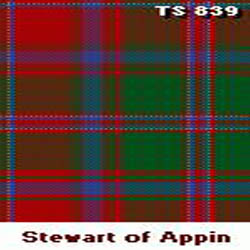
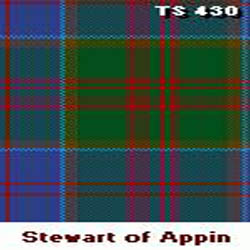
Clan Stewart of Appin Tarten modern (left) Hunting Tarten (right)
(Retrieved on 2 April 2008 from www.stewartsociety.org/objects/object_pages/Clan_Tartans.htm )
In 1497 the Stewarts and MacLarens carried out a combined raid against MacDonald of Keppoch as a reprisal for cattle
reiving, but Dugald Stewart was killed and succeeded as Chief of Appin by his son Duncan. King James IV of Scotland,
born in 1473, was a cousin of the Stewarts of Appin and when he came of age made frequent hunting journeys to the
Highlands. It is understood that he stayed quite often at Castle Stalker, using it as a base for hunting and hawking
for which he had a passion. It is thought that further improvements were made to the Castle at this time including the
possible addition of what is now the top floor and roof, and that the Coat of Arms over the front door may be the Royal
Arms of that time.
Duncan Stewart was murdered by the McLeans at Duart Castle in 1512 and succeeded by his younger brother Alan Stewart as
the third Chief. In 1513 the Stewarts of Appin supported King James IV at the Battle of Flodden. Stewart Chief and his
five sons were all present at the Battle. all managed to survive what was otherwise a massive defeat in which the King was killed.
In 1520 Sir Alexander Stewart of Invernahyle was fishing off the small island next to Castle Stalker when he was surprised
and murdered by a party of Campbells. Tradition has it that the nurse of his baby son, Donald Stewart, hid the baby in the
Castle and when the Campbells left the nurse returned, found the baby still alive and took refuge in Morven. Young Donald
became renowned for his strength and was known as "Donald of the Hammers" – in the Gaelic "Donald nan Ord" – as he could
wield a blacksmith's hammer in each hand with ease.
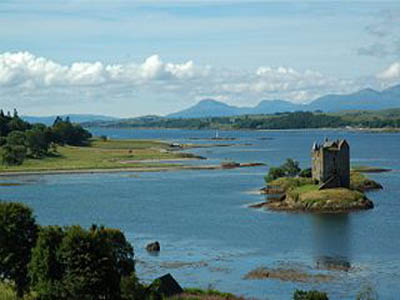
In recent times the castle was brought to fame by the Monty Python team, appearing in their film Monty Python and the Holy
Grail. The Castle's implausibly picturesque appearance, with its bewitching island setting against a ramatic backdrop of
mountains, has made it a favourite subject for postcards and calendars, and something of a cliché image of Scottish Highland
scenery. It should be noted, however, that Stalker is entirely authentic; it is one of the best-preserved medieval tower-houses
surviving in western Scotland. (photo retrieved on 2 April 2008 from http://en.wikipedia.org/wiki/Castle_Stalker)
In 1544 he raised the Stewarts of Appin and went to Dunstaffnage where they killed nine Campbells in revenge for the murder
of his Father. Donald nan Ord also led the Stewarts at the Battle of Pinkie on the 10th September 1547. He died in 1607 and
is buried on Lismore where his faithful henchman, a Carmichael, also lies buried. In around 1620 the Castle passed into the
hands of the Campbells of Airds as a result of a drunken wager by the 7th Stewart Chief, Duncan, in exchange for an eight-oared wherry.
The Stewarts of Appin, under Stewart of Ardsheal, regained the Castle in 1689 when they came out with King James VII (otherwise
James II) against King William but after defeat at the battle of Dunkeld the Castle was again forfeited to the Campbells. The Stewarts
under Ardsheal refused to hand it over when it was then besieged by the Campbells for several months until Ardsheal was granted an
honourable surrender in 1690.
At the time of the 1745 Rising Castle Stalker was held by the Campbells with a Garrison of about 59 Government troops. Although the
Stewarts of Appin were solidly behind Prince Charles, and raised a regiment of 300, the Castle was too strong for them to take and
their 2lb cannon-balls merely bounced off the walls. The Castle formed an important link during the rising with ships calling frequently
with men and supplies as they sailed between Inverary in the South and Fort William in the North. After the Battle of Culloden in 1746
the Castle was used by the Government forces as a local centre where the Clansmen had to surrender their arms. Six prisoners are recorded
as being held in the Prisoners' Hole for about a fortnight before being taken to Edinburgh for trial.
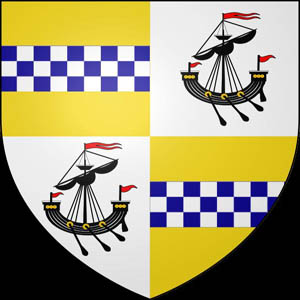
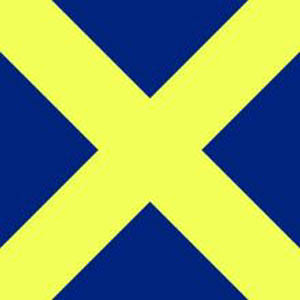
A gold saltire on a blue field as flown by Stewart of Appin's regiment at the Battle of Culloden during the 1745 Jacobite uprising to
restore Bonnie Prince Charlie as King of Scotland. This stardard was not captured by government troops after the battle. The arms of
the Stewart of Appin, Chief of Clan Stewart of Appin (retrieved on 10 Aug 2010 from http://en.wikipedia.org/wiki/Clan_Stewart_of_Appin)
The last Campbell was born in the Castle in 1775 and Campbells continued to reside in it until about 1800 when they built a new house
on the mainland at Airds, which still exists today, and the Castle remained merely as a storehouse. In about 1840 the roof either fell
in or was perhaps removed to avoid roof-tax and the Castle was abandoned.
In 1908 the Castle was regained from the Campbells by Charles Stewart of Achara who purchased it and carried out some basic preservation
work to stem its decay. In 1947 his successor, Duncan Stewart, who was Governor of Sarawak, was murdered by a Dyak and the Castle
devolved on his widow. In 1965 Lt. Col. D. R. Stewart Allward negotiated terms for the purchase of the Castle and spent the next ten years
rebuilding and restoring it as it is today. It is now fully habitable. Contractors and builders in the normal sense were not employed in
the restoration which was carried out by Lt. Col. Stewart Allward personally with the help of his wife, family and many friends who were
willing to spend holidays and long weekends helping with the task. He died suddenly whilst out walking in 5th February 1991 and is survived
by his wife Marion and children Sine, Ross, Alasdair, and Morag.”(retrieved on 10 Aug 2010 from http://www.castlestalker.com/castlle.htm)
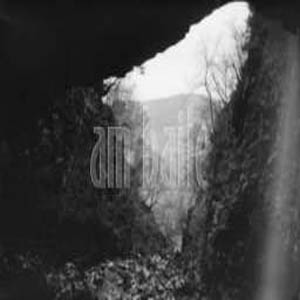
This is the view from inside of Stewart’s Cave or Ardsheal’s cave. The stream of water can be seen on the right hand side of the photo.
(retrieved on 10 Aug 2010 from http://www.ambaile.org.uk/en/item/item_photograph.jsp?item_id=35464)
An interesting story pertaining to the Battle of Culloden participation by Clan Stewart of Appin: “On 23 July 1745 Prince Charles Edward Stuart
(Bonnie Prince Charlie) landed on the white sands of the Outer Hebridean island of Eriskay, accompanied only by a small band of companions
known as the "Seven Men of Moidart. This was the start of his claim to the Scottish and English throne and the second Jacobite uprising; on 16
April 1746 the Jacobite cause was finally put to rest at the battle of Culloden.
Charles Stewart of Ardsheal, one of the Prince’s commanding officers, hid from the English Red Coats in a cave as they searched up and down the
country for those involved. This place was henceforth known as Ardsheal’s Cave. Sitting on a steep hillside above Kentallen Bay in Loch Linnhe
on the West coast of Scotland, between Oban and Fort William, the cave is no more than forty minutes scramble from the loch side.
The Stewarts of Ardsheal were the most important Cadet family of the Stewarts of Appin. Totally loyal to the Jacobite cause, Stewart of Ardsheal
led the regiment raised by the Stewarts of Appin at Culloden. They suffered appalling casualties when breaking the ranks of Barrell’s and Munro’s
regiments of foot of the Hanoverian army. However the outcome of Culloden was almost certain before it began. The Jacobite army, tired, hungry,
improperly equipped and grossly out numbered were decisively defeated. After their victory the English, lead by The Duke of Cumberland, were
ordered to execute all the Jacobite wounded and imprisoned. For this he was hereafter known as “The Butcher”. Having escaped death both in battle
and the immediate aftermath Stewart of Ardsheal made for his family seat, Ardsheal House, Kentallen Bay. His hope was that if he could evade
capture for long enough some sort of amnesty or deal would eventually be struck. Nevertheless none of the Jacobite’s in this predicament could
imagine the determination and ruthlessness of Cumberland.
Over the coming months 3,500 Jacobite’s were rounded up and imprisoned; of these 120 were immediately executed (mainly clan leaders) and a further
90 died in prison. 1,000 were transported to the colonies and 250 “banished”. 700 disappeared, their fate unknown. In addition the clan system was
destroyed with the Act of Proscription, they were disarmed and the kilt and tartan banned.
It was in this climate that Ardsheal returned home and knowing full well his fate, should he be caught, immediately went into hiding. He wanted to
be near his wife and new born son so with her help he hid in the cave above his house. His wife would bring food and occasionally he would
venture out under cover of darkness. Eventually the Red Coats came and Ardsheal House was cordoned off and his wife and child held prisoner.
She must have been a brave woman because she gave nothing away claiming that she hadn’t seen or heard of her husband since he left with the
Jacobite army. The Red Coats thoroughly searched the surrounding area whilst Ardsheal himself was hiding under their noses. One account states
that on two occasions they walked within yards of his hideout.
The secret of Ardsheal’s success was with the cave itself or more importantly its situation. It lies behind a tall waterfall which completely
hides the entrance especially when the burn is in flood. Unless you know of its whereabouts you could be standing five yards away and never
find it. It stretches back some fifteen or twenty feet and is easy to stand up in however; it tapers down to no more than two or three feet at
the back. The walls and floor are a bit damp but there is a dryer place towards the rear. Nevertheless it is perfectly comfortable and completely
sheltered from the elements outside. It can only be approached from one way – directly up the steep sided burn and is far enough away from Ardsheal
House to make it a fairly arduous and demanding climb.
If however, your position is known then escape is virtually impossible. The constant noise of falling water drowns out any approaching sounds
and your only way out is the same as the way in. Your pursuers would be on you in seconds before you could take a step – you’d be caught like
a rat in a trap. On the whole though it makes a perfect hiding place and one can imagine avoiding detection indefinitely and in complete safety.
That said, Charles Stewart of Ardsheal was known to have been a large man of great personal strength and a proficient swordsman - one of the best in the highlands. One can’t help but think that he was like a caged lion and impatient to leave.
The threat of capture for Charles Stewart of Ardsheal continued long after the Red Coats had left Ardsheal House. If it wasn’t an English soldier
who turned him in it was more likely to be a fellow Scotsman particularly from the South. The Jacobite cause was to put a catholic King back on the
throne, this was considered by many as taking a step backwards. For the Lowland Presbyterians the defeat of the Jacobites was a cause for
celebration. The Union and the Presbyterian system of church government were safe. Realising that no amnesty was ever likely to be forthcoming
Ardsheal eventually fled to France and his lands were forfeited to the Crown. His son Duncan Stewart of Ardsheal succeeded in having the lands
restored later in the eighteenth century and the Stewarts of Ardsheal then succeeded to the Chiefdom of Appin upon the extinction of the Appin
family.”








